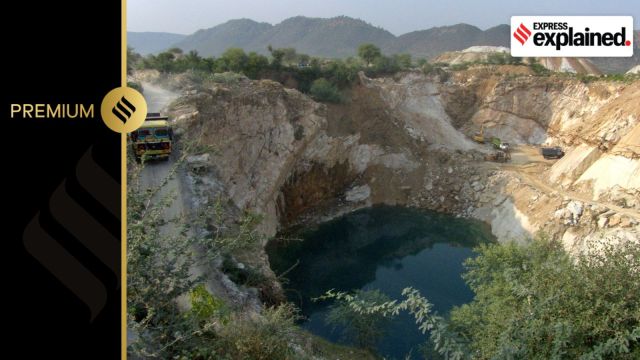- India
- International
Explained: The history of Supreme Court orders against illegal mining in Sariska reserve
SC has been trying to stop illegal mining in and around Sariska tiger reserve since 1991. It has been thwarted for reasons that include uncertainty about the reserve’s borders. A new order presents another opportunity.
 A quarry in operation in the core area of Sariska. (Express photo by Jay Mazoomdaar)
A quarry in operation in the core area of Sariska. (Express photo by Jay Mazoomdaar)The Supreme Court has ordered the Rajasthan government to shutter 68 mines operating within a 1-kilometre periphery of the critical tiger habitat (CTH) of the Sariska reserve. The order, passed on May 15, is the latest of many attempts by the country’s top court since the 1990s to halt the mining of marble, dolomite, and limestone in Sariska in violation of laws.
Both the Wildlife Protection Act, 1972 and Environment Protection Act, 1986 prohibit quarrying in and around a tiger reserve.
In the 1990s
In May 2005, the SC ordered the CBI to investigate the disappearance of tigers from the reserve in the Aravalli roughly halfway between Delhi and Jaipur. That was almost a decade and a half after the court first took up the issue of illegal mining in Sariska.
In October 1991, in a PIL filed by a local NGO, the SC issued an interim order that “no mining operation of any nature shall be carried on in the protected area” of Sariska, and set up a fact-finding committee under the chairmanship of Justice M L Jain, a retired judge of the High Court.
Based on a “traced map provided by the Forest Department,” the Jain Committee found in 1992 that the protected areas covered “about 800 sq km”. In April 1993, the SC ordered the closure of 262 mines within that area.
In the 2000s

Ten years later, the Central Empowered Committee (CEC) of the SC submitted a damning report on mining around the Jamua Ramgarh Sanctuary which is part of the Sariska tiger reserve. The following year, the NGO Goa Foundation approached the SC with a complaint about a similar situation in Goa.
 Mining at Sariska’s Jamua Ramgarh sanctuary. (Express photo by Jay Mazoomdaar)
Mining at Sariska’s Jamua Ramgarh sanctuary. (Express photo by Jay Mazoomdaar)
In September 2005, the SC laid down rules for issuing temporary mining permits in forest areas. In August 2006, it said, “as an interim measure, one-kilometre safety zone shall be maintained subject to the orders that may be made…regarding Jamua Ramgarh Sanctuary”.
But the mines were back in business in 2008 after the Rajasthan government claimed that the sanctuary boundary had been demarcated, and allowed quarries outside the 100-metre periphery of the sanctuary. The state stuck to the 100-metre regulation in its draft Eco-Sensitive Zone (ESZ) notification for Sariska in 2011.
Meanwhile, in January 2002, the Indian (now National) Board for Wildlife had proposed to notify areas within 10 km of national parks and sanctuaries as ESZs. But after several state governments expressed concerns, the Board had asked them, in May 2005, to identify suitable areas and submit proposals for site-specific ESZs.
After many states failed to respond, the SC intervened in December 2006. The court warned that if the states failed to respond within four weeks, it might have to consider the original plan of ESZs of 10-km width.
In the 2010s
In September 2012, the CEC submitted a report on ESZs that went beyond Sariska. In January 2013, it followed up with a supplementary note on the “inordinate delay” in notifying the safety zones.
The SC put its foot down in April 2014. Its judgment in the Goa Foundation case underlined that the August 2006 order “has not been varied subsequently nor any orders made regarding Jamua Ramgarh”, and that “the order…saying that there will be no mining activity within one-kilometre safety zone…has to be enforced”.
But it took another four years for the SC to act on its 2006 order. In December 2018, noting that 21 of the country’s 662 national parks and sanctuaries were yet to submit ESZ proposals even 12 years after the deadline had passed, the court ordered that 10-km belts around them be declared ESZs.
In the 2020s
After the 2003 CEC report, several miners joined the case concerning Sariska’s Jamua Ramgarh sanctuary. The apex court finally ruled on the matter in June 2022. It ordered ESZs of a minimum width of 1 km for all national parks and sanctuaries, but limited it to 500 metres for Jamua Ramgarh sanctuary as a “special case” with some leniency.
After multiple objections to this one-size-fits-all approach, however, the SC modified the 2022 order in April 2023. The modified order left the specifics of ESZs to the Centre and the state, and focussed on mining — prohibiting it within 1 km of national parks and sanctuaries.
On May 15, the SC criticised the Rajasthan government for misinterpreting this order as being not applicable to tiger reserves. The court clarified that the 2023 direction applied to tiger reserves which “stand on a higher pedestal”.
Background of problem
Local people in Sariska have repeatedly demanded the demarcation of forest boundaries on the ground. Villagers have alleged that soft boundaries allow illegal mines to operate legally on paper by showing their locations outside the reserve. Also, to make up for the areas lost to such concessions, revenue villages are alleged to have been arbitrarily included in the tiger reserve, impinging on the rights of residents.
A decade after Sariska became a tiger reserve in 1978, Rajasthan issued mining leases inside the reserve to many who had obtained no-objection certificates (NOCs) from the then field director of Sariska, even though he did not have any authority to issue such NOCs.
In 1993, Rajasthan’s proposal to compensate for these illegal mines by adding 5 sq km of revenue land to the reserve was rejected by the SC. But the ‘swap’ happened anyway, according to two retired forest officials who have served in the Alwar district.
Uncertain boundaries
The area statement records submitted to the SC in 1993 did not tally with the accompanying map. The discrepancies were so glaring that the surveyor was constrained to add a face-saver on the map: “Prepared by me as per the direction of FD (Forest Department), PT (Project Tiger), Sariska.”
In 1999, the Sariska management claimed to have lost several land records. The forest bosses in Jaipur then borrowed the said records from the Revenue Department, which in 2003 claimed these documents were never returned.
In August 2008, when Rajasthan approached the Survey of India to undertake the demarcation work in Sariska, the then state forest head wrote in a letter that “the exact boundary, including the location of pillars, is not known”. Survey of India backed out of the job because Rajasthan failed to provide reliable maps and records.
In the absence of demarcated boundaries, Sariska’s Tiger Conservation Plan could not be finalised until 2014-15 when the state finally prepared a map for “management purposes” with a disclaimer against its legal authenticity.
Another opportunity
A senior official in the Rajasthan Forest Department said the latest SC order was yet another opportunity to thwart illegal mining in the state. “Whatever mistakes were made in the past can be set right by demarcating the no-go zones around Sariska and also other mining-affected reserves of the state,” he said.
The case comes up again in July.
More Explained
EXPRESS OPINION
Jun 12: Latest News
- 01
- 02
- 03
- 04
- 05








































